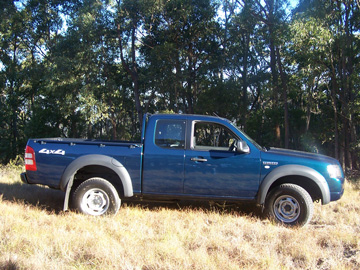|
Home | News | Road Tests | ||||
ROAD TEST: Ford Ranger XL (Diesel) by Ken Walker 30th March, 2009Home > Road Tests > Ford Ford Australia replaced the ageing Courier with a vehicle again sourced from its alliance partner Mazda. Known as the Ranger, it is available in 2 trim levels, the XL or the XLT. Three body styles are offered, single cab, super cab or double cab. Each is available as a cab/chassis or utility. Additionally, all are available as 4 x 2 or 4 x 4. Transmission choices are 5 speed manual or a four speed automatic (5 speed auto on XLT). Engines choice is limited. The 4x2 models are fitted with a 2.5 litre CTd engine, whilst 4x4 models come with a 3.0 litre common rail turbo diesel. To my way of thinking this makes a lot of sense, as I believe diesel is the better fuel for both 'work horses' and play vehicles. This time out, the Next Car team tries the Ford Ranger Super Cab XL 4 x 4 utility with a 5 speed manual transmission. On a quick visit to a state forest with badly corrugated and pot holed gravel road, we thought the ride was a little harsh but not unbearable. A bit of weight in the cargo tray would, in my mind, settle the package down and improve the ride. The unit was fitted with 235/75R15 all terrain tyres and not the usual highway pattern (one of the first utes we have noticed with this style of tyre) ..... Ford must be reading our reviews! On the rough surface there was no sign of slipping or spinning wheels. On the exterior, the panels were evenly fitted and free of rattles. Painted surfaces were good. This consultant likes the 'Super Cab' style of body as it offers some flexibility to carry small passengers, whilst still having a long tray for bulky or lengthy cargo. Better still get a slide-on camper with a pop-top roof and get away from it all on the weekend or holidays. This package is built for it. The super cab type of cabin is known amongst competitor vehicles as a space cab, extra cab or even king cab. In this package the small panel behind the drivers’ door hinges on the rear edge eliminating the need of a ‘B’ pillar. For younger passengers there are 2 seating positions on thin, but comfortable drop down swabs. Two lap/sash seat belts are fitted for restraining purposes. Without passengers, the space for stowing extra gear is enhanced, particularly for attractive (valuable) equipment. Inside the super cab, the driver and front seat passenger are well catered for with the inclusion of dual front airbags. The driver has within reach and vision, switches for adjusting the power mirrors, power windows (front doors only) and the controls for the single disc in-dash CD player with an AM/FM radio. The front bucket seats are comfortable and adjustable for rake, as well as fore and aft to suit the drivers’ height. The dash is well laid out with the standard instruments clearly marked. Air conditioning is standard. The hand brake is mounted under the dash with an umbrella type handle that needs to be pulled outwards, twisted and pushed back in. We are probably being picky but this is very old 'technology' and only the Ford/Mazda alliance are using this system. Of course, it still works though. The 3.0 litre high pressure direct injection turbo diesel is an excellent choice of power source; it pumps out a respectable 115 kW of power and a very capable 380 Nm of torque. Fuel economy, as quoted by Ford, is 9.2 litres/100 km (tested in accordance with the ADR 81/01 standard). The fuel used during our 630 kilometre 'run' in the Ranger seemed very reasonable. Fuel tank capacity is 70 litres. Fully independent double wishbone front suspension keeps the front end on track with dual rate semi-elliptic leaf spring rear suspension ensures that the rated load of 1,175 kgs is carried without any problems. A limited slip differential is standard on 4 x 4 versions. Our test package had a tow capacity of 3,000 kilogrammes for a trailer fitted with electric brakes and 750 kgs for an unbraked trailer. Vehicles fitted with automatic transmissions are limited to 2,500 kgs with a braked trailer. Stopping power is provided through front ventilated disc brakes with self adjusting rear drum brakes. We would prefer disc brakes all round, particularly on 4 x 4 models. That's because water crossings suit vehicles with disc brakes, as drum brakes take awhile to dry out. This does not distract from the capability of the fitted system, though. Overall, the Ford Ranger XL Supercab utility is a versatile package with optional extras available for individual enhancement. With a choice of 10 colours, 2 trim levels and 3 body styles with either cab/chassis or utility, there is a wide choice available for the astute consumer. Ford has been a long time supplier of tough 'work horses' and the Ranger shows all the characteristics of keeping that position alive in Australia. | ||||
More Ford News ..... here About | Car Clubs | Home | News | Road Ramblings | Road Tests | Subscribe | Top Drive © 2009 All rights reserved. Next Car Pty. Ltd. |



